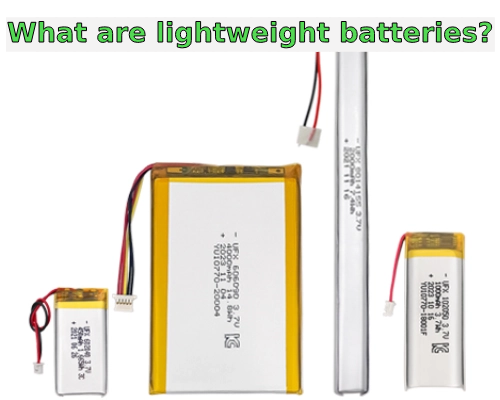Lightweight batteries have emerged as indispensable components across various industries. Whether it’s powering our smartphones, laptops, electric vehicles, or even wearable devices, the demand for lightweight, high-performance batteries continues to soar. In this comprehensive guide, we’ll delve into the definitions, explore the types, and conduct comparisons of lightweight batteries to help you make informed decisions regarding your power needs.
Part 1. What are lightweight batteries?
Definitions:
Lightweight batteries are small and light devices that store and deliver energy to power various electronic devices. Their design emphasizes portability and efficiency, providing a reliable power source without unnecessary weight.
Composition:
- Electrodes: They are the parts of the battery where chemical reactions occur to store and release energy. Lightweight batteries often use electrodes made from materials like lithium, which are lightweight and have high energy storage capacity.
- Electrolyte: The electrolyte is a substance that allows ions to move between the electrodes, facilitating the flow of electric current. In lightweight batteries, the electrolyte is usually a liquid or gel-like material chosen for its conductivity and stability.
- Separator: The separator is a thin membrane that keeps the electrodes from touching each other while allowing ions to pass through. This prevents short circuits and ensures the safe and efficient operation of the battery.
- Casing: The casing is the battery’s outer shell that protects its internal components and provides structural support. Lightweight batteries often use lightweight materials like plastic or aluminum for the casing to minimize weight without compromising durability.
Part 2. Types of lightweight batteries
Lithium-ion Batteries
- Composition: Lithium-ion batteries consist of lithium-ion cells, which contain a lithium cathode, a graphite anode, and an electrolyte solution.
- Characteristics: Their lightweight construction and high energy density characterize lithium-ion batteries. They offer fast charging capabilities, long cycle life, and low self-discharge rates. These batteries are known for their relatively low maintenance requirements and wide operating temperature range.
- Applications: Consumer electronics, electric vehicles, and renewable energy storage systems widely use lithium-ion batteries. They power devices such as smartphones, laptops, tablets, and power tools, providing portable and reliable energy sources for everyday use.
Lithium-polymer Batteries
- Composition: Lithium-polymer batteries use a polymer electrolyte instead of a liquid electrolyte, allowing for a more flexible and lightweight design.
- Characteristics: Unlike traditional lithium-ion batteries, lithium-polymer batteries are lightweight and flat, enabling more creative and space-efficient designs. They offer high discharge rates and improved safety features, making them suitable for applications requiring lightweight and compact power sources.
- Applications: Drones, remote-controlled vehicles, and wearable devices commonly use lithium-polymer batteries, especially when space and weight constraints are critical. They also find favor in medical and aerospace applications, where reliability and safety are paramount.
Solid-state Batteries
- Composition: Solid-state batteries feature a solid electrolyte instead of a liquid or gel electrolyte, offering enhanced safety and energy density.
- Characteristics: Solid-state batteries distinguish themselves through lightweight construction, improved safety, and higher energy density than traditional lithium-based batteries. They offer longer cycle life and faster charging rates, making them ideal for applications requiring high-performance and reliable power sources.
- Applications: While still in the early stages of development, solid-state batteries show promise for electric vehicles, portable electronics, and renewable energy storage systems. Their lightweight and compact design makes them well-suited for applications where space and weight are critical factors.
Zinc-air Batteries
- Composition: Zinc-air batteries use zinc metal and oxygen from the air as reactants, with a potassium hydroxide electrolyte.
- Characteristics: Zinc-air batteries are known for their lightweight construction and high energy density. They offer long-lasting power and are environmentally friendly, as they use oxygen from the air as one of the reactants.
- Applications: Zinc-air batteries find everyday use in hearing aids, where their lightweight design and long battery life are essential. Additionally, researchers are exploring their potential applications in electric vehicles and grid-scale energy storage systems due to their high energy density and low cost.
Nickel-metal Hydride (NiMH) Batteries
- Composition: NiMH batteries consist of a nickel oxyhydroxide cathode, a metal hydride anode, and a potassium hydroxide electrolyte.
- Characteristics: Nickel-metal hydride batteries are known for their lightweight construction and good balance between energy density and safety. They offer a reliable and cost-effective alternative to lithium-based batteries.
- Applications: Various applications utilize NiMH batteries, including consumer electronics, hybrid vehicles, and portable power tools. They value them for their relatively low environmental impact and recyclability compared to other battery chemistries.
Part 3. Comparisons of lightweight batteries
1. Material Composition
- Lithium-ion Batteries: Composed of lithium-ion cells with a lithium cathode, graphite anode, and liquid electrolyte.
- Lithium-polymer Batteries: Utilize a polymer electrolyte instead of liquid, allowing for a more flexible and lightweight design.
- Solid-state Batteries: Feature a solid electrolyte instead of liquid or gel, providing enhanced safety and stability.
- Zinc-air Batteries: Utilize zinc metal and oxygen from the air as reactants with a potassium hydroxide electrolyte.
- Nickel-metal Hydride (NiMH) Batteries: Consists of a nickel oxyhydroxide cathode, metal hydride anode, and potassium hydroxide electrolyte.
2. Shape and Flexibility
- Lithium-ion Batteries Typically come in cylindrical or prismatic shapes, offering limited flexibility in design.
- Lithium-polymer Batteries Can be made into various shapes and sizes, allowing for more creative and space-efficient designs.
- Solid-state Batteries Offer flexibility in design due to their solid-state nature, enabling innovative form factors.
- Zinc-air Batteries Generally have a standard shape due to their design requirements, offering limited flexibility.
- Nickel-metal Hydride (NiMH) Batteries: Available in standard cylindrical or prismatic shapes with limited flexibility.
3. Charging Speed
- Lithium-ion Batteries: Known for fast charging capabilities, with typical charging times ranging from 1 to 3 hours for a full charge.
- Lithium-polymer Batteries: Similar charging speeds to lithium-ion batteries, total charges achieved within 1 to 3 hours.
- Solid-state Batteries: Expected to offer even faster charging speeds than traditional batteries, with potential for total charges in under an hour.
- Zinc-air Batteries: Charging speeds may vary but are generally slower than lithium-based batteries, with total charges taking several hours.
- Nickel-metal Hydride (NiMH) Batteries: Relatively moderate charging speeds, with total charges achieved within 2 to 4 hours.
4. Energy Density
- Lithium-ion Batteries Offer high energy density, providing long-lasting power in compact sizes.
- Lithium-polymer Batteries: Slightly lower energy density compared to lithium-ion, but compensate with flexibility in design.
- Solid-state Batteries: Boast enhanced energy density compared to traditional batteries, promising more power in smaller packages.
- Zinc-air Batteries Provide competitive energy density, making them suitable for long-lasting applications like hearing aids.
- Nickel-metal Hydride (NiMH) Batteries: They have relatively lower energy density than lithium-based batteries but are still sufficient for many applications.
5. Cycle Life
- Lithium-ion Batteries offer a long cycle life and can endure approximately 500 to 1000 charge and discharge cycles before noticeable degradation.
- Lithium-polymer Batteries: Similar to lithium-ion batteries, providing reliable performance over approximately 500 to 1000 cycles.
- Solid-state Batteries: They have a longer cycle life than conventional batteries, estimated at 1,000 to 5,000 cycles or more.
- Zinc-air Batteries: Moderate cycle life, with an estimated lifespan of approximately 300 to 500 cycles, depending on usage conditions.
- Nickel-metal Hydride (NiMH) Batteries Provide a decent cycle life, typically lasting for approximately 300 to 500 cycles before a significant capacity loss occurs.
6. Safety
- Lithium-ion Batteries: They can be prone to thermal runaway under certain conditions and require careful handling.
- Lithium-polymer Batteries: Improved safety features compared to traditional lithium-ion batteries, offering better resistance to leakage and overheating.
- Solid-state Batteries: Known for enhanced safety due to the absence of flammable liquid electrolytes, reducing the risk of fire or explosion.
- Zinc-air Batteries: Generally considered safe but may suffer from degradation due to exposure to moisture.
- Nickel-metal Hydride (NiMH) Batteries: Relatively safe and stable, with minimal risk of thermal runaway.
Part 4. FAQs
-
What are the lightest batteries?
The lightest batteries are typically lithium-based, such as lithium-ion and lithium-polymer batteries. These batteries are known for their high energy density and lightweight construction. -
Are lightweight batteries worth it?
Yes, lightweight batteries are worth it for many applications. They offer portability, longer runtime, and improved efficiency compared to heavier alternatives. Lightweight batteries provide valuable benefits, Whether powering portable electronics or electric vehicles. -
How much does a lightweight battery weigh?
The weight of a lightweight battery depends on its type, capacity, and design. However, on average, lightweight batteries can weigh anywhere from a few grams to a few kilograms. For example, a small lithium-ion battery used in a smartphone may weigh around 20 to 50 grams. In contrast, larger batteries used in electric vehicles can weigh several hundred kilograms. -
Are lithium batteries lightweight?
Lithium batteries, particularly lithium-ion and lithium-polymer batteries, are known for their lightweight construction. They offer high energy density, providing significant power output in a compact, lightweight package. -
Which batteries are lighter?
Lithium-based batteries, such as lithium-ion and lithium-polymer batteries, are generally lighter than other types of batteries, like nickel-metal hydride (NiMH) or lead-acid batteries. These lithium-based batteries offer a combination of lightweight construction and high energy density, making them popular choices for various applications.
Related Tags:
More Articles

GoPro Battery Charger Guide: Top Picks & Pro Charging Tips
Explore the best GoPro chargers, compare third-party options, and learn how to charge smarter for longer battery life.
GoPro Battery Life Comparison: How Long Does a GoPro Battery Last?
Find out how GoPro battery life varies by model and get practical advice to maximize runtime for every adventure.
What Battery Powers Your GoPro?
Learn all about GoPro batteries - compatibility, runtime, charging tips, and how to extend battery life for longer shoots.
What Is a Disk Battery? A Simple Guide for Non-Tech Users
A disk battery is a small, round cell used in watches, remotes, and other electronic devices. It delivers steady power for compact, low-drain devices.
What Battery Powers a Space Heater?
Discover the type of battery that powers space heaters and learn how to choose the right one for efficient heating in your home or office.




